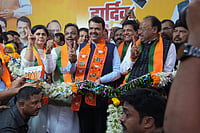A Borges-type labyrinthine, the Bhulbhulaiya, haunts the Bada Imambara - its plush ceiling invokes early '60s restaurant decor. The Romanesque arches, Egyptian designs and amazingly 20th century brickwork of Dilkusha (an early 19th century building) shocked a newly-arrived European delegation of architects. They were reminded of a 20th Century Fox set, being unaware that Lucknavi tastes have long seeped into Indian cinema.
Remember Leena Chandravarkar's rust cenna sharara, Asha Parekh's dupatta tied to the chignon, Sharmila Tagore's jaali blouse, even Helen's slit lehngas, in the '60s and the '70s? The classical, wheatish, gudas badan, sensational (sansanikhez) Lucknavi beauty struck a rugged stance in a sophisticated manner. She defined the Lucknavi ada evident in Urdu shairi, the Dussheri mango, jinsiyat (sexology), Hindi scriptwriting, Begum Akthar, the UP school of hockey, tennis and humour, Hindustani detective fiction - and private attitudes. The decapitating, 'aliberal' Lucknavi response to English writing in India? Khafifa adalat mein ullu ke patthe, raage gul se bulbul ke par baandhte hain (a famous, early 20th century couplet by Braj Narain Chakbast that translates loosely as 'The owls (fools) of the lower-law-court that represents the real world, tie the wings of the 'metal world nightingale' with floral veins'!). Rs 1,000 for getting the present connection right.
















